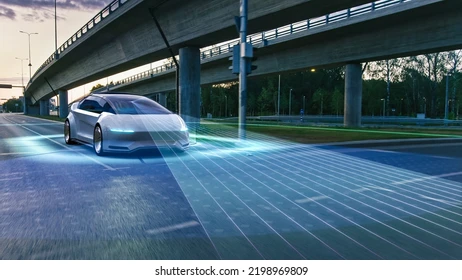Autonomous Vehicle Technology: Navigating the Future of Transportation
Introduction:
The dawn of autonomous vehicle technology marks a pivotal moment in the history of transportation. From science fiction to a tangible reality, self-driving cars are poised to redefine how we move and interact with the world around us. This article explores the intricate landscape of autonomous vehicle technology, shedding light on the underlying mechanisms, the potential impact on society, and the challenges that lie on the horizon.
I. The Technological Foundation:
At the heart of autonomous vehicle technology lies a sophisticated blend of hardware and software, working in tandem to navigate the complexities of the road. The evolution of this technology is marked by breakthroughs in artificial intelligence (AI), sensor technology, and connectivity.
A. Sensor Fusion:
Autonomous vehicles rely on a diverse array of sensors to perceive their surroundings. Cameras capture visual information, lidar systems use laser beams to create a 3D map of the environment, radar detects objects, and ultrasonic sensors provide proximity data. The synergy of these sensors creates a comprehensive understanding of the vehicle’s surroundings, forming the backbone of autonomous navigation.

B. Artificial Intelligence as the Brain:
The true intelligence behind autonomous vehicles resides in the onboard computers equipped with powerful AI algorithms. These algorithms process and interpret the vast amounts of data generated by sensors, enabling the vehicle to make split-second decisions. Machine learning plays a pivotal role, allowing the system to adapt and improve over time based on real-world experiences.
II. The Promise of Autonomous Vehicles:
A. Safety and Accident Reduction:
One of the primary promises of autonomous vehicle technology is the potential to revolutionize road safety. The majority of accidents are attributed to human error, which can be mitigated with self-driving cars that do not suffer from fatigue, distraction, or impaired judgment. Advanced sensors and AI algorithms enhance the vehicle’s ability to anticipate and respond to potential hazards, reducing the risk of collisions.
B. Accessibility and Inclusivity:
Autonomous vehicles have the potential to transform transportation for individuals who face limitations, such as the elderly and people with disabilities. The prospect of independent mobility for those unable to drive holds profound societal implications, fostering inclusivity and empowering individuals with newfound freedom.
C. Traffic Efficiency and Optimization:
Autonomous vehicles, interconnected through advanced communication systems, can optimize traffic flow and reduce congestion. The ability to coordinate movements in real time can lead to more efficient use of road infrastructure, shorter commute times, and a significant reduction in traffic-related stress.
III. Technological Challenges:
A. Environmental Factors and Adverse Conditions:
While autonomous vehicles excel in controlled environments, they face challenges in unpredictable and adverse conditions. Factors like heavy rain, snow, or obscured road markings can pose difficulties for current sensor technologies. Researchers are actively working on developing robust systems capable of handling a diverse range of weather and road conditions.
B. Ethical Dilemmas and Decision-Making:
The introduction of autonomous vehicles raises ethical questions concerning decision-making in critical situations. How should a self-driving car prioritize the safety of occupants versus pedestrians in emergency scenarios? Addressing these ethical dilemmas requires a delicate balance between technological capabilities and societal values.
C. Regulatory Framework and Standardization:
The legal and regulatory landscape for autonomous vehicles is still evolving, presenting a significant hurdle to widespread adoption. Establishing a comprehensive framework that addresses safety, liability, and ethical considerations is paramount. Standardization across industries and regions is necessary for creating a cohesive and globally accepted approach.
IV. The Path to Adoption:
A. Incremental Integration:
The journey towards fully autonomous vehicles is likely to be incremental. Many automakers are already incorporating semi-autonomous features, such as adaptive cruise control and lane-keeping assistance, into their vehicles. This phased approach allows for both technology and society to adapt gradually.
B. Public Perception and Acceptance:
Public trust is a critical factor in the adoption of autonomous vehicles. Open communication about the technology, its capabilities, and its limitations is essential in building trust. Demonstrating the safety benefits and addressing concerns related to cybersecurity and job displacement are key elements in garnering public support.
V. Future Implications:
A. Urban Planning and Infrastructure:
The rise of autonomous vehicles will undoubtedly influence urban planning and infrastructure. Cities may need to reconsider road designs, parking facilities, and traffic management systems to accommodate the unique needs of self-driving cars. The integration of smart infrastructure will play a crucial role in supporting the seamless operation of autonomous fleets.
B. Economic and Societal Shifts:
The widespread adoption of autonomous vehicles could bring about profound economic and societal shifts. Industries related to transportation may undergo transformations, creating new job opportunities in areas such as vehicle maintenance, software development, and data analytics. The societal impact of increased mobility and accessibility can reshape how communities are designed and function.
Conclusion:
Autonomous vehicle technology stands at the intersection of innovation and transformation. The fusion of AI, sensor technologies, and connectivity holds the promise of safer, more efficient, and inclusive transportation. However, the road to widespread adoption is not without challenges. Overcoming technological hurdles, addressing ethical considerations, and establishing a robust regulatory framework are critical steps in realizing the full potential of autonomous vehicles. As we navigate this uncharted terrain, the evolution of autonomous vehicle technology will undoubtedly shape the future of transportation, leaving an indelible mark on the way we experience mobility.